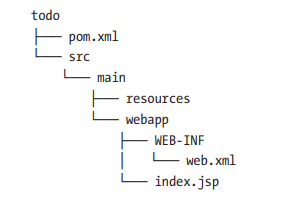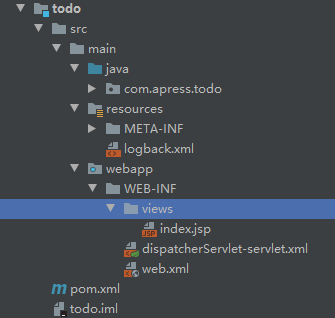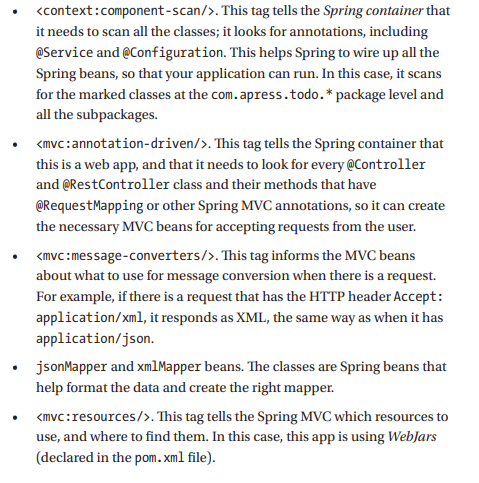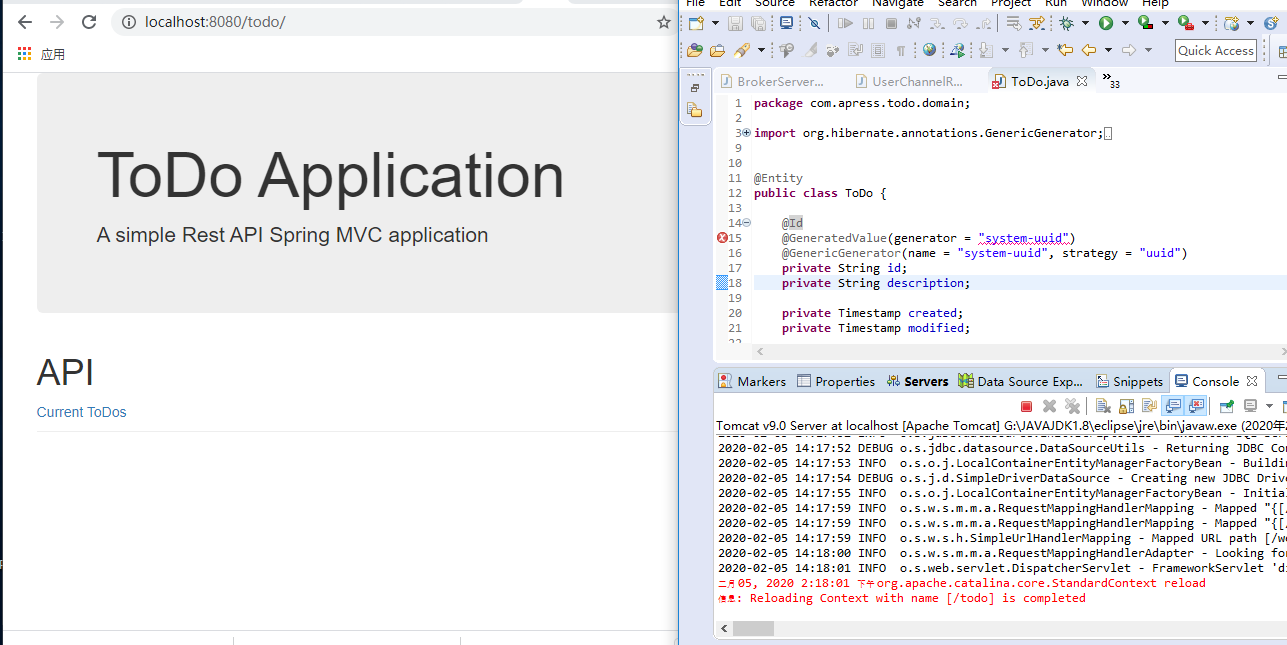先来看下手动配置bean的过程(第一章还没使用Spring Boot)
A Simple Spring Web Application
Let’s start by creating a Spring web application— a ToDo app that offers a REST API that can do a CRUD (create, read, update, and delete). To create a new Spring app, you need to have Maven installed. In the following chapters, you can choose either Maven or Gradle.



其中schema.sql内容如下:
create table todo ( id varchar(36) not null, description varchar(255) not null, created timestamp, modified timestamp, completed boolean, primary key (id) );
data.sql内容如下:
insert into todo values ('7fd921cfd2b64dc7b995633e8209f385','Buy Milk','2018-09-23 15:00:01','2018-09-23 15:00:01',false); insert into todo values ('5820a4c2abe74f409da89217bf905a0c','Read a Book','2018-09-02 16:00:01','2018-09-02 16:00:01',false); insert into todo values ('a44b6db26aef49e39d1b68622f55c347','Go to Spring One 2018','2018-09-18 12:00:00','2018-09-18 12:00:00',false);
各个java文件见书中详解
Next, let’s configure the Spring context by creating a dispatcherServlet-servlet. xml file. There is a naming convention; if the servlet is named todo in the web.xml file, then the Spring context file should be named todo-servlet.xml. In this case, the servlet was named dispatcherServlet, so it looks for a dispatcherServlet-servlet.xml file (see Listing 1-3).
dispatcherServlet-servlet.xml
<?xml version="1.0" encoding="UTF-8"?> <beans xmlns="http://www.springframework.org/schema/beans" xmlns:xsi="http://www.w3.org/2001/XMLSchema-instance" xmlns:context="http://www.springframework.org/schema/context" xsi:schemaLocation=" http://www.springframework.org/schema/beans http://www.springframework.org/schema/beans/spring-beans.xsd http://www.springframework.org/schema/context http://www.springframework.org/schema/context/spring-context-4.3.xsd"> <context:component-scan base-package="com.apress.todo" /> </beans> <!-- <?xml version="1.0" encoding="UTF-8"?> <beans xmlns="http://www.springframework.org/schema/beans" xmlns:xsi="http://www.w3.org/2001/XMLSchema-instance" xmlns:context="http://www.springframework.org/schema/context" xmlns:mvc="http://www.springframework.org/schema/mvc" xmlns:jpa="http://www.springframework.org/schema/data/jpa" xmlns:jdbc="http://www.springframework.org/schema/jdbc" xmlns:tx="http://www.springframework.org/schema/tx" xsi:schemaLocation="http://www.springframework.org/schema/jdbc http://www.springframework.org/schema/jdbc/spring-jdbc-4.3.xsd http://www.springframework.org/schema/mvc http://www.springframework.org/schema/mvc/spring-mvc-4.3.xsd http://www.springframework.org/schema/beans http://www.springframework.org/schema/beans/spring-beans.xsd http://www.springframework.org/schema/context http://www.springframework.org/schema/context/spring-context-4.3.xsd http://www.springframework.org/schema/data/jpa http://www.springframework.org/schema/data/jpa/spring-jpa-1.8.xsd http://www.springframework.org/schema/tx http://www.springframework.org/schema/tx/spring-tx-4.3.xsd"> <context:component-scan base-package="com.apress.todo" /> <mvc:annotation-driven> <mvc:message-converters> <bean class="org.springframework.http.converter.json.MappingJackson2HttpMessageConverter"> <property name="objectMapper" ref="jsonMapper"/> </bean> <bean class="org.springframework.http.converter.xml.MappingJackson2XmlHttpMessageConverter"> <property name="objectMapper" ref="xmlMapper"/> </bean> </mvc:message-converters> </mvc:annotation-driven> <bean id="jsonMapper" class="org.springframework.http.converter.json.Jackson2ObjectMapperFactoryBean"> <property name="simpleDateFormat" value="yyyy-MM-dd HH:mm:ss" /> </bean> <bean id="xmlMapper" parent="jsonMapper"> <property name="createXmlMapper" value="true"/> </bean> <mvc:resources mapping="/webjars/**" location="classpath:META-INF/resources/webjars/" /> <jpa:repositories base-package="com.apress.todo.repository" /> <jdbc:embedded-database id="dataSource" type="H2"> <jdbc:script location="classpath:META-INF/sql/schema.sql" /> <jdbc:script location="classpath:META-INF/sql/data.sql" /> </jdbc:embedded-database> <bean id="jpaVendorAdapter" class="org.springframework.orm.jpa.vendor.HibernateJpaVendorAdapter"> <property name="showSql" value="true" /> </bean> <bean id="entityManagerFactory" class="org.springframework.orm.jpa.LocalContainerEntityManagerFactoryBean"> <property name="dataSource" ref="dataSource" /> <property name="jpaVendorAdapter" ref="jpaVendorAdapter"/> </bean> <bean id="transactionManager" class="org.springframework.orm.jpa.JpaTransactionManager"> <property name="entityManagerFactory" ref="entityManagerFactory"/> </bean> <tx:annotation-driven transaction-manager="transactionManager" /> <bean class="org.springframework.web.servlet.view.InternalResourceViewResolver"> <property name="prefix" value="/WEB-INF/views/" /> <property name="suffix" value=".jsp" /> </bean> <bean id="h2WebServer" class="org.h2.tools.Server" factory-method="createWebServer" init-method="start" destroy-method="stop"> <constructor-arg value="-web,-webAllowOthers,-webDaemon,-webPort,8082" /> </bean> - </beans> -->



As you can see, this part requires a little bit of knowledge on how to wire up Spring. If you want to understand more, I recommend several books from the Apress, including Pro Spring 5, by I. Cosmina, et al.

最终效果:

If you click the link, you should have an XML response
可以看到把in-memory数据库中的数据全部都取了出来(由于使用了findAll方法)
So, what do you think of the Spring Framework? Yes, you need to understand what is happening. You need to know how the Spring beans lifecycle works and how the dependency injection is being used. Also, it is important to know a little AOP (aspectoriented programming) because it’s part of the magic of wiring everything to work for us. Do you think it’s too much? Well, if you try to make the same app with a regular Java 2 EE profile, it will be even more work. Remember, it’s not only exposing a REST API, but working with a database, transactions, message converters, view resolvers, and more; that’s why with Spring, web apps are easier to create. But guess what? Spring Boot dos all the boilerplate configuration for you, which speeds up development time by creating enterprise Spring apps!
Summary
There is a lot to learn about the Spring Framework and the role it plays with Spring Boot. A single chapter won’t be enough. So, if you want to know more about it, I encourage you to review the Spring documentation at https://docs.spring.io/spring-framework/ docs/current/spring-framework-reference/. In the next chapter, we start with Spring Boot and learn how easy it is to create the same application we did in this chapter, but “à la Boot.